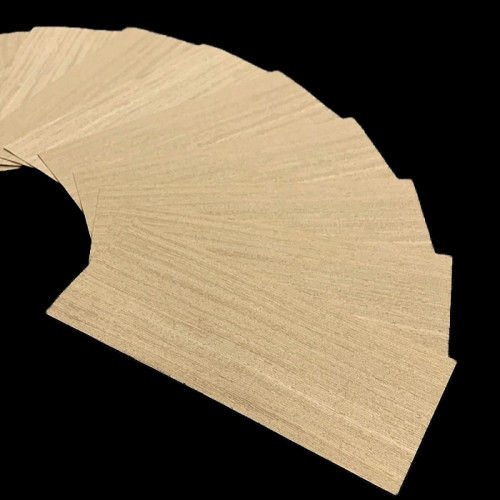
Lati Veneers Narrow Width Small-size Veneers
Lati Veneers Narrow Width Small-size Veneers
Genuine wood sliced-veneer sheets.
Fix length of 30 cm long.
Width: From 10 to 14 cm.
Thickness: 0.55 mm.
Sold by the sheet.
Lati Veneers Narrow Width Small-size Veneers
Genuine wood sliced-veneer sheets.
Dimensions:
Fix length of 30 cm long.
Width: From 10 to 14 cm.
Thickness: 0.55 mm.
Sold by the sheet.
Measurement scaling:
Width rounded to the covered centimeter: 15.8, giving 15 cm.
Species:
Common Names:
Lati, White Wenge, Yaya.
Botanical Name:
Amphimas pterocarpoides and Amphimas ferrugineus.
Origin:
Lati is an African wood, mainly found in Central and West Africa.
Appearance:
It is called White Wenge because its grain and structure are similar to Wenge, especially when cut on the quarter. However, its color is straw yellow with small white veins.
This wood is generally used for decorative projects and luxury items. Lati is also used in the production of dyed veneers in the mass to offer a wood similar to Wenge.
Properties:
This wood has a moderate resistance to outdoor conditions.
Although it is a wood with a notable hardness, it is brittle in the direction of the grain. Like Wenge, watch out for splinters, they bite.
Weight: about 785 kg/m3 at 10-12% humidity.
Janka Hardness: 5340 Newton, for comparison: Oak is 4980 N and Poplar is 1650 N.
Modulus of elasticity: 14.81 GigaPascal, for comparison: US Maple 12.62 GPa and Poplar 9.75 GPa.
Uses:
Lati wood is used for interior joinery, flooring, mouldings, furniture, decorative veneers.
It is also used for the manufacture of musical instruments and works of art.
Product Description:
Genuine wood-sliced veneer sheets.
These veneers are raw without a finish or any fleece back.
The veneer surface is similar to plane wood. However, it will be preferable to forecast a light sanding after gluing.
The veneers are offered here as wood-sliced sheets of one and unique thickness.
Both faces of these veneers are the same, without fleece back, without glue.
Even if the veneer's sides had been cut relatively straight, it isn't a precise parallel clipping; some veneers may have kept the decreasing shape of the tree, wider at the bottom end and narrower at the top end.
Very occasionally, some veneers' sides have traces of unclipped wane, but our veneers are measured at the narrowest, as explained in the paragraph "sizes."
As genuine natural wood, all finishing products are acceptable as long these products are meant to be used for wood.
The choice of the finished product must be consistent with the final usage realization.
Use of the veneers:
Cutting:
Veneers can be easily cut with a utility knife.
For straight cuts, the best results are obtained with a veneer saw.
Use a fretsaw, scalpel, or veneer knife for curved cuts.
Always allow for a slightly larger veneer sheet than your intended surface. This will allow you to adjust the size after gluing for a clean finish.
A flush trimmer can also be used to trim the veneer after gluing.
When cutting with a utility knife or veneer knife, it is best to cut with the grain of the wood. To check this, run your finger along the edge of the sheet. The direction that feels smoothest is the ideal direction for cutting.
Gluing:
Several types of gluing are possible.
With vinylic glue, the veneer is pressed over its entire surface.
With neoprene glue for all surfaces, especially non-porous surfaces, by applying two coats of glue and marouflage.
With animal glue such as hide, sinew, or bone glue.
With vinyl glue and an iron, apply two thin coats of glue to each piece. This technique should only be used if other gluing techniques are not possible.
Sanding:
Veneers and all our products are wood and can be sanded according to their thickness.
Regardless of the thickness of the veneer, do not use a belt sander, as this could pierce it.
With a 0.6 mm veneer, lightly sand with 120 grit and then finish with 180 or 240 grit. With an orbital sander, 180 grit is already sufficient for most applications.
Finishing:
All finishing products generally used for wood are suitable for finishing our products. For example, you can use a varnish, wax, paint, or oil.
However, ensure that the product you want to use is compatible with the final use of your creation.
Photos:
To keep the cost of these products as cheap as possible and contrary to other veneers on this website, the pictures of small-size veneers do not represent the available stock.
More information:
Please look at our TUTORIALS; you might find some valuable tips.
Please contact us by email or phone for any additional information.
Data sheet
- Species
- Lati
- Thickness group
- Standard
- Width group
- Narrow width
- Grade
- Quarter-cut
 English
English




